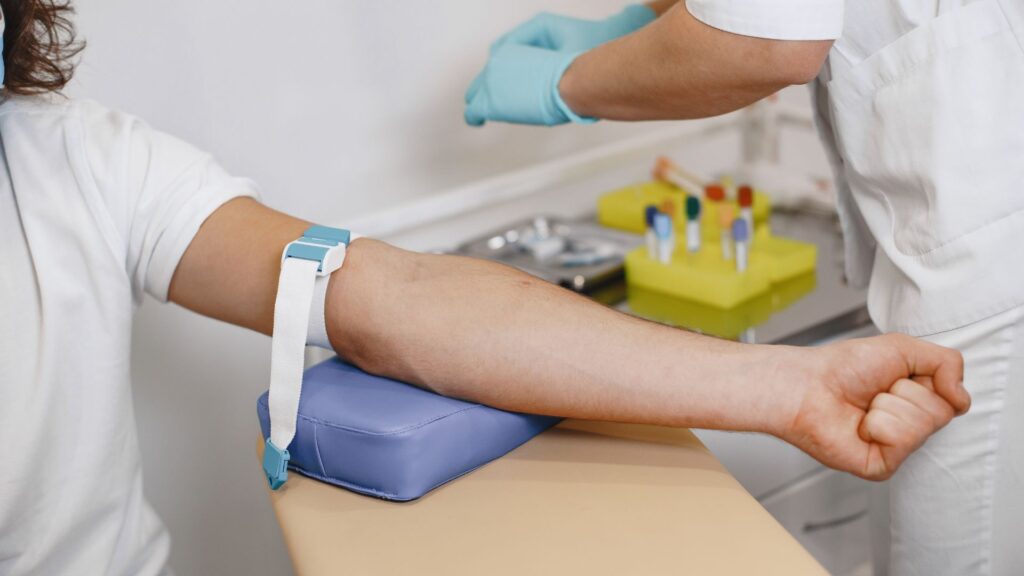Let me introduce you to Susan – an upbeat schoolteacher from Brisbane who loves her job and afternoon yoga. She seems just like any other person, but what you might not guess is that Susan regularly needs to have her blood removed. Surprised? Intrigued? That’s the power of a procedure called a venesection.
Indicators
Venesection is a powerful tool for managing certain health conditions. But which conditions exactly? Let’s dig deeper:
- Blood Disorders: Conditions such as polycythaemia and porphyria cutanea tarda can lead to excessive blood cells or rogue enzymes. Venesection helps regulate these.
- Haemochromatosis: Our patient Susan has this condition, leading to excessive iron accumulation. It’s like a sponge absorbing too much water, with Susan’s body being the sponge and iron being the water.
- Long-Term Consequences: Unchecked, iron overload could lead to severe complications like cirrhosis, heart disease, and even cancer.
- Venesection as a Lifeline: Regular venesections help Susan manage her iron levels effectively. It’s akin to squeezing out excess water from the sponge, restoring balance and reducing severe health risks. In a nutshell, venesection is not just about blood removal—it’s about life enhancement for patients like Susan.
Causes of Conditions Necessitating Venesection
- Genetic Factors: Mutations in genes, like the HFE gene in haemochromatosis, can lead to excess iron or blood cells.
- Other Conditions: Chronic alcoholism, certain types of anaemia, and exposure to toxins can also necessitate venesections.
Treatment
Frequency of Venesections
- The frequency of venesections is determined by disease severity, the patient’s health, and response to treatment.
- Initial frequency may be high; for Susan, it was every two weeks. Once iron levels are under control, frequency can be reduced; Susan moved to quarterly venesections.
Complications from Venesections
- Venesections are generally safe, but can have side effects like dizziness, fainting, bruising, or infection at the needle site.
- Rare, but more serious complications like blood clots may occur.
Next Steps
The Urgent Care Brisbane Approach
At Urgent Care Brisbane, the team understands the apprehensions and fears patients may have around venesections. That’s why they take a step-by-step approach, prioritizing patient comfort and safety. Here’s how it works:
- Consultation: Doctors at Urgent Care Brisbane discuss the need for venesections based on the patient’s condition and blood tests. Patients like Susan get a thorough understanding of the procedure and its benefits.
- Procedure: The venesection itself typically takes around 15 minutes, but patients are asked to reserve about an hour for the whole process. A trained professional gently inserts a needle into a vein, often in the arm, and blood is collected into a bag.
- Monitoring: Post-venesection, the patient is monitored for any immediate side effects. Light refreshments are provided, and they are advised to avoid strenuous exercise for the next 24 hours.
- Follow-up: Regular follow-ups with blood tests are scheduled to monitor the condition, adjusting the venesection frequency as required.
Susan recalls her first venesection with a shudder. But with each visit to Urgent Care Brisbane, her anxiety lessened. The knowledgeable, compassionate staff and their meticulous process made her comfortable. Today, she manages her condition with a combination of diet, lifestyle changes, and regular venesections.
While we often consider blood removal in the context of blood donations, venesections serve as a critical tool for those like Susan, helping to manage their conditions and maintain their quality of life.
Remember, as much as we thrive on the incredible complexities of modern medicine, sometimes the simplest solutions – like removing some blood or decreasing red blood cells – can have the most profound impacts. If you or a loved one are dealing with a condition requiring venesections, know that facilities like Urgent Care Brisbane are here to guide you through every step of the process.
Venesections might sound intimidating at first, but as Susan’s story illustrates, they can become a regular part of one’s life – a little pinch for a huge health payoff. So let’s remember to spread awareness, challenge stigmas and misconceptions, and, as always, prioritize our health.
As we’ve followed Susan’s journey, we can see that therapeutic venesections have a crucial role in treating certain conditions, enabling individuals to continue leading their lives with minimal disruption. From this point on, whenever you hear the term ‘venesection,’ think of it not as a daunting medical procedure, but as a beacon of hope for people like Susan – empowering them to take control of their health.
Remember, no matter what medical issue you might face, you’re not alone. Reach out to health professionals like those at Urgent Care Brisbane, get informed, and take an active role in managing your health.
Whether it’s understanding the indications for venesection, acknowledging potential complications, or getting to grips with the procedure’s frequency, knowledge is power. Arm yourself with it, and, like Susan, you can navigate your healthcare journey with confidence and grace.
The world of medicine is full of stories like Susan’s – stories of resilience, perseverance, and the unyielding human spirit. As we continue to explore these stories, let us celebrate our collective health and wellbeing, appreciating the medical miracles that are, often, just a venesection away.

